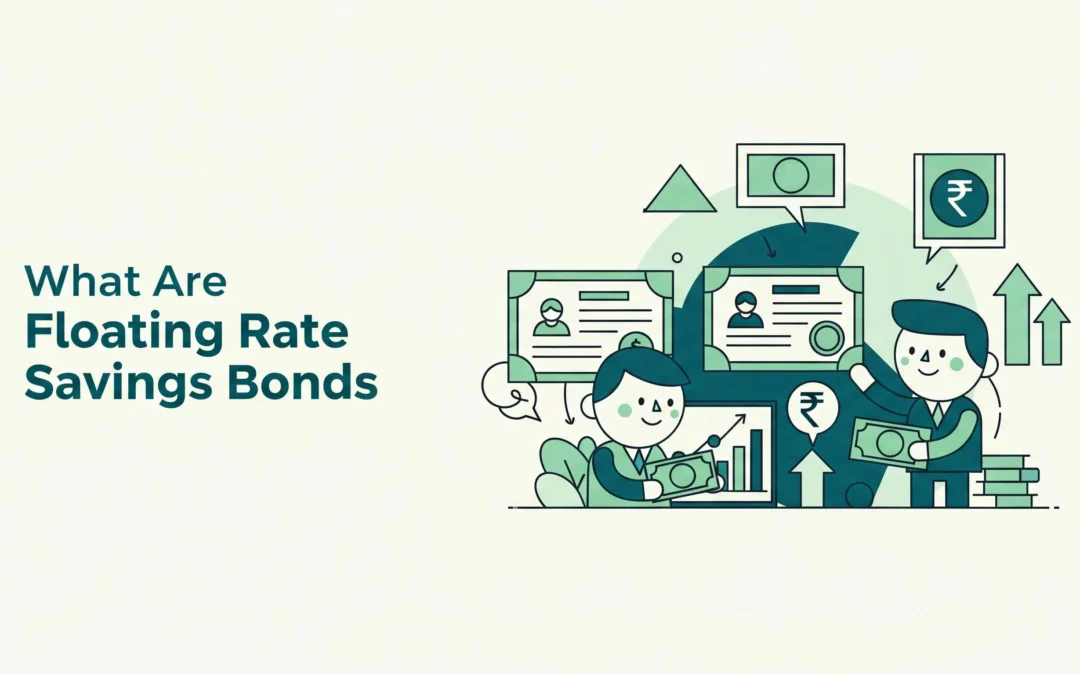Investing your hard-earned money comes with a lot of responsibility. With so many options available, choosing one can be difficult. Not every investor goes to a financial advisor to build their portfolio. Personal research is the key to increasing your returns and building wealth. One such option is FRSB(Floating Rate Savings Bonds), which is ideal for long-term investors. These bonds come with a lock-in period and very low risk as they are issued by the government.
FRSBs are explained in detail with all the pros and cons they hold. It will help you to decide whether they can be a valuable part of your portfolio or not.
What are Floating Rate Savings Bonds?
Floating Rate Savings Bonds are issued by the Reserve Bank of India(RBI), which are debt instruments mainly targeted at retail investors seeking a safe investment option with variable interest rates. These bonds, in contrast to fixed deposits or fixed-rate government bonds, feature a variable interest component, meaning that the return you receive fluctuates according to the state of the market.
How Do Floating Rate Savings Bonds Work?
The interest rate on FRBS is not set and is fluctuating in nature. It is reset every six months and is based on the National Savings Certificate (NSC) interest rate plus a fixed spread of 35 basis points (0.35%).
Issuer’s Promise:
The Reserve Bank of India (RBI) issues these bonds directly on behalf of the national government. There is no default risk, and they are among the safest investment options available because they carry a guarantee.
Interest Distributions:
FRSBs pay interest semi-annually, which is directly credited to your registered bank account. On the other hand, other funds have cumulative options that compound interest and pay it at maturity. They are appropriate for people seeking steady income at a regular interval, like conservative investors or retirees.
Dates of Payout:
- January 1
- July 1
Lock-in Time and Early Withdrawal
The bonds will mature seven years after they are issued. However, there are some exceptions to the duration after which premature withdrawal is allowed.
| Age Group of Investor | Lock-in Before Premature Withdrawal Allowed |
| 60 to 70 years | After 6 years |
| 70 to 80 years | After 5 years |
| Above 80 years | After 4 years |
Rules Regarding Taxation
- The full interest earned is taxed under the heading “Income from Other Sources.”
- It is subject to taxation at the rate of the investor’s applicable income tax slab.
- TDS is deducted at 10% on Floating Rate Savings Bonds interest only if it exceeds ₹10,000 in a financial year (from October 1, 2024). You can avoid TDS by submitting Form 15G/H if eligible.
Pros and Cons of Purchasing Floating Rate Bonds?
There are several benefits to floating rate savings bonds, particularly in situations where interest rates are rising or uncertain.
Benefits:
- Growing Income Potential: Your returns could rise remarkably with interest rate increases because the rate is reset every six months.
- Government Guarantee: There is no credit risk because it is sovereignly backed.
- Inflation Hedge: If interest rates are modified appropriately, it helps offset inflation to some extent, as the interest rate is adjusted every 6 months.
- Easy to invest: Available online through RBI Retail Direct or a few banks.
Restrictions:
- Not transferable or tradable on stock exchanges
- Extended lock-in period of seven years, with certain exceptions.
- Interest is paid out every six months; there is no cumulative option.
- Unlike PPF or tax-free bonds, these are fully taxable.
Floating Rate Bonds vs Other Fixed Income Options
Floating Rate Savings Bonds (FRSBs) have a distinct advantage over other fixed income options such as Fixed Deposits (FDs), National Savings Certificates (NSCs), and conventional government bonds, which is a dynamic interest rate that fluctuates with the market, potentially yielding higher returns in an environment of rising interest rates.
FRSBs provide a hedge against fluctuating rates by realigning every six months based on the NSC rate, whereas FDs and NSCs offer fixed returns over their tenure. FRSBs don’t offer tax advantages like PPF or NSC, and their seven-year lock-in may restrict liquidity. However, FRSBs offer a good balance between return and risk for investors who value capital safety, consistent income, and rate responsiveness, especially during periods of rising inflation and interest rates.
| Instrument | Rate of Return | Lock-in Period | Tax Benefit | Risk Level |
| FRSB | Floating (8.05%) | 7 years | No | Very Low |
| Fixed Deposits | Fixed (6–8%) | 1–10 years | No (except 5-yr FD) | Low |
| National Savings Certificate(NSC) | Fixed (7.7%) | 5 years | Yes (u/s 80C) | Very Low |
| Mutual Funds | Market linked | Flexible | Depends on type | Low to High |
Bottomline
The conclusion can be drawn that FRSBs are a good investment option for people who are looking for long-term investments. It also helps in tackling inflation as the interest rate is adjusted every 6 months. People who look forward to a regular income source and also to preserving their capital may opt for this option. However, there is no tax benefit available, and if you are inclined towards conservative growth, this might be the right option for you.
Choosing this option depends on the investor’s profile and other factors like suitability, capital available, etc.
Written by: Tanya Kumari


